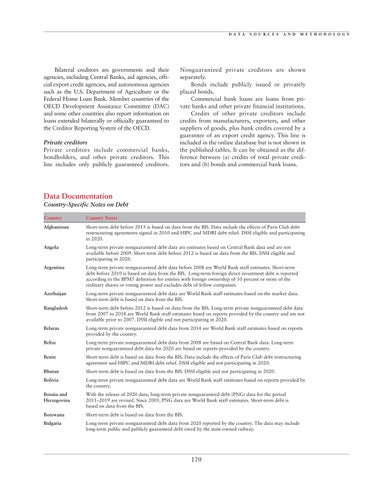D a t a
Bilateral creditors are governments and their agencies, including Central Banks, aid agencies, official export credit agencies, and a utonomous agencies such as the U.S. Department of Agriculture or the Federal Home Loan Bank. Member countries of the OECD Development Assistance Committee (DAC) and some other countries also report information on loans extended bilaterally or officially guaranteed to the Creditor Reporting System of the OECD.
Private creditors Private creditors include commercial banks, bondholders, and other private creditors. This line includes only publicly guaranteed creditors.
S o u r c e s
a n d
M e t h o d o l o g y
onguaranteed private creditors are shown N separately. Bonds include publicly issued or privately placed bonds. Commercial bank loans are loans from private banks and other private financial institutions. Credits of other private creditors include credits from manufacturers, exporters, and other suppliers of goods, plus bank credits covered by a guarantee of an export credit agency. This line is included in the online database but is not shown in the published tables. It can be obtained as the difference between (a) credits of total private creditors and (b) bonds and commercial bank loans.
Data Documentation Country-Specific Notes on Debt Country
Country Notes
Afghanistan
Short-term debt before 2015 is based on data from the BIS. Data include the effects of Paris Club debt restructuring agreements signed in 2010 and HIPC and MDRI debt relief. DSSI eligible and participating in 2020.
Angola
Long-term private nonguaranteed debt data are estimates based on Central Bank data and are not available before 2009. Short-term debt before 2012 is based on data from the BIS. DSSI eligible and participating in 2020.
Argentina
Long-term private nonguaranteed debt data before 2008 are World Bank staff estimates. Short-term debt before 2010 is based on data from the BIS. Long-term foreign direct investment debt is reported according to the BPM5 definition for entities with foreign ownership of 10 percent or more of the ordinary shares or voting power and excludes debt of fellow companies.
Azerbaijan
Long-term private nonguaranteed debt data are World Bank staff estimates based on the market data. Short-term debt is based on data from the BIS.
Bangladesh
Short-term debt before 2012 is based on data from the BIS. Long-term private nonguaranteed debt data from 2007 to 2018 are World Bank staff estimates based on reports provided by the country and are not available prior to 2007. DSSI eligible and not participating in 2020.
Belarus
Long-term private nonguaranteed debt data from 2014 are World Bank staff estimates based on reports provided by the country.
Belize
Long-term private nonguaranteed debt data from 2008 are based on Central Bank data. Long-term private nonguaranteed debt data for 2020 are based on reports provided by the country.
Benin
Short-term debt is based on data from the BIS. Data include the effects of Paris Club debt restructuring agreement and HIPC and MDRI debt relief. DSSI eligible and not participating in 2020.
Bhutan
Short-term debt is based on data from the BIS. DSSI eligible and not participating in 2020.
Bolivia
Long-term private nonguaranteed debt data are World Bank staff estimates based on reports provided by the country.
Bosnia and Herzegovina
With the release of 2020 data, long-term private nonguaranteed debt (PNG) data for the period 2011–2019 are revised. Since 2005, PNG data are World Bank staff estimates. Short-term debt is based on data from the BIS.
Botswana
Short-term debt is based on data from the BIS.
Bulgaria
Long-term private nonguaranteed debt data from 2020 reported by the country. The data may include long-term public and publicly guaranteed debt owed by the state-owned railway.
179

